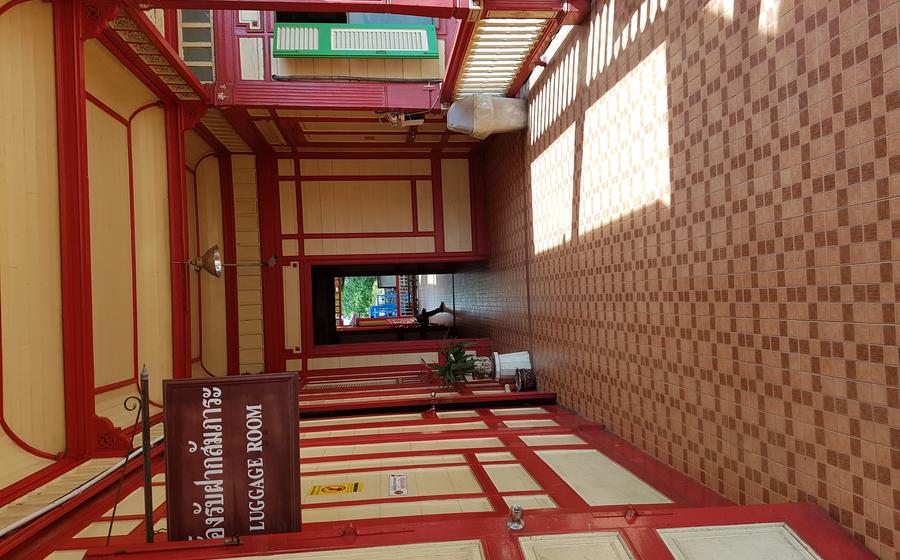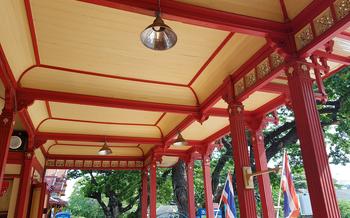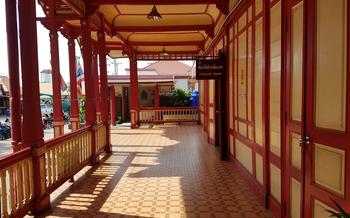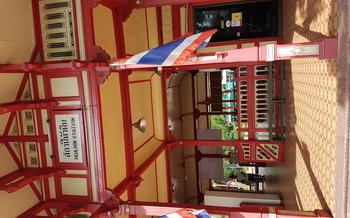
Wat Amparam
- Hua Hin's Ancient Temple: Unveiling Wat Amparam's History
- Reaching the Sacred Grounds: Directions to Wat Amparam
- Awe-Inspiring Architecture: Exploring Wat Amparam's Structures
- The Grand Buddha Image: A Symbol of Reverence
- Intricate Murals and Paintings: A Journey Through Buddhist Art
- Paying Homage to the Monks: A Glimpse into Monastic Life
- Festivals and Celebrations: Joining the Festivities at Wat Amparam
- Finding Inner Peace: Meditation and Retreats at Wat Amparam
- The Royal Connection: Wat Amparam's Ties to the Monarchy
- Local Legends and Folklore: Uncovering Wat Amparam's Mysteries
- Admiring the Gardens: Serenity Amidst Nature
- Supporting the Temple: Donations and Volunteer Opportunities
- Photography and Videography Guidelines: Capturing Memories Respectfully
Hua Hin's Ancient Temple: Unveiling Wat Amparam's History
Nestled amidst the vibrant city of Hua Hin, Wat Amparam stands as a testament to Thailand's rich cultural heritage and deep-rooted Buddhist traditions. This ancient temple, with its intricate architecture and sacred grounds, has played a significant role in the spiritual and historical tapestry of the region for centuries.
Historical Significance
Wat Amparam was founded in the 19th century during the reign of King Rama IV, also known as King Mongkut. It was built by a group of devoted monks who sought to create a serene and sacred space for meditation and religious ceremonies. Over the years, the temple has undergone several renovations and expansions, each contributing to its unique architectural style and cultural significance.
Architectural Style
Wat Amparam showcases a harmonious blend of traditional Thai and Chinese architectural elements. The main temple building, known as the ubosot, features intricate carvings, colorful murals, and a distinctive curved roof adorned with intricate finials. The chedi, or stupa, rises majestically behind the ubosot, symbolizing the Buddha's attainment of enlightenment.
Cultural Importance
Wat Amparam holds a profound cultural significance for the people of Hua Hin and beyond. It is not only a place of worship but also a center for community gatherings, religious festivals, and cultural performances. The temple's serene atmosphere and sacred energy attract both locals and tourists seeking spiritual fulfillment and a glimpse into Thailand's rich Buddhist heritage.
Religious Ceremonies
Wat Amparam is a vibrant center for religious ceremonies and rituals. Throughout the year, the temple hosts numerous events, including merit-making ceremonies, ordination ceremonies, and Buddhist holidays such as Visakha Puja and Asalha Puja. These ceremonies are a testament to the deep faith and devotion of the Thai people and offer visitors a unique opportunity to witness the rich traditions of Thai Buddhism.
Reaching the Sacred Grounds: Directions to Wat Amparam
To reach the sacred grounds of Wat Amparam, a journey from the bustling city center of Hua Hin awaits. Embark on a scenic drive, following the winding roads that lead you towards the serene embrace of the temple. For those without their own vehicles, taxis and tuk-tuks stand ready to transport you to this spiritual haven.
Public transportation offers a budget-friendly alternative, with buses and songthaews plying the route to Wat Amparam. Simply hop aboard and let the local transportation system guide you to the temple's gates.
Upon arrival, ample parking space greets you, ensuring a convenient start to your sacred exploration. For those with limited mobility, the temple's accessible design provides ramps and designated parking areas, ensuring that all visitors can partake in the temple's spiritual offerings.
Awe-Inspiring Architecture: Exploring Wat Amparam's Structures
Wat Amparam's architectural ensemble is a testament to the grandeur and artistry of Thai temple design. The main temple building, known as the viharn, is the heart of the complex, housing the revered Buddha image. Its intricate carvings, gilded stupas, and colorful murals depict scenes from Buddhist mythology and history.
The ubosot, or ordination hall, is another significant structure within the temple grounds. This sacred space is reserved for important ceremonies such as ordinations and monkhood initiations. Its walls are adorned with intricate murals depicting the life of Buddha, while the roof features elaborate gable decorations and finials.
The chedi, or stupa, is a tall, bell-shaped structure that symbolizes the Buddha's relics and teachings. At Wat Amparam, the chedi stands as a majestic monument, its gleaming white surface reflecting the sunlight and drawing the eyes of visitors from afar.
Finally, the sala, or assembly hall, is a multi-purpose space used for community gatherings, religious teachings, and meditation sessions. Its open design and airy atmosphere create a welcoming environment for visitors to relax, contemplate, and connect with the temple's serene energy.
The Grand Buddha Image: A Symbol of Reverence
At the heart of Wat Amparam, a majestic sight awaits visitors—a colossal Buddha image that exudes an aura of tranquility and reverence. Towering over the temple grounds, this awe-inspiring statue commands attention with its sheer size and intricate details.
The Buddha image at Wat Amparam is not just a work of art; it holds immense spiritual significance for the local community and visitors alike. Crafted with meticulous precision, the image embodies the essence of serenity and compassion, inviting devotees to seek solace and guidance within its presence.
The history of this grand statue is shrouded in mystery, adding to its allure. While its exact origins remain unknown, many believe it dates back to the temple's early years, making it a cherished relic of Wat Amparam's rich heritage.
Throughout the day, the Buddha image receives offerings and prayers from devoted worshippers. Devotees place flowers, light incense sticks, and chant mantras, seeking blessings and expressing their gratitude. The atmosphere around the statue is palpable, filled with a sense of devotion and spiritual connection.
Whether you're a devout Buddhist or simply an admirer of art and history, the Grand Buddha Image at Wat Amparam is a sight to behold. Its serene presence and intricate details are sure to leave a lasting impression, inviting you to delve deeper into the temple's sacred spaces and embrace the tranquility that permeates the air.
Intricate Murals and Paintings: A Journey Through Buddhist Art
Within the sacred walls of Wat Amparam, visitors are captivated by the exquisite murals and paintings that adorn the temple's interior. These artistic masterpieces, created by skilled artisans with meticulous precision, depict a myriad of Buddhist themes and subjects, inviting visitors to embark on a visual journey through the history and teachings of Buddhism.
The murals and paintings showcase a diverse range of artistic techniques and styles, from traditional Thai to contemporary influences. Each brushstroke, each color hue, and each intricate detail contributes to the overall narrative, conveying stories of the Buddha's life, Buddhist cosmology, and moral parables.
Beyond their aesthetic beauty, these murals and paintings hold profound symbolism and hidden meanings, inviting viewers to contemplate the deeper spiritual truths and teachings embedded within them. They depict scenes from the Buddha's previous lives, illustrating the concept of karma and reincarnation. They portray heavenly realms and hells, conveying the consequences of one's actions. And they depict mythological creatures and divine beings, representing the interconnectedness of all things in the Buddhist universe.
As visitors gaze upon these sacred artworks, they are transported to a realm of spiritual contemplation, where the teachings of Buddhism come alive through visual storytelling. The murals and paintings of Wat Amparam serve as a reminder of the power of art to inspire, uplift, and guide us on our own spiritual journeys.
Paying Homage to the Monks: A Glimpse into Monastic Life
Wat Amparam is not just a place of worship but also a thriving monastic community. The monks residing here dedicate their lives to Buddhist teachings and practices, embodying the principles of compassion, mindfulness, and spiritual growth. Visitors to the temple have the unique opportunity to interact with these monks and gain insights into their daily routines and beliefs.
The monks of Wat Amparam rise early each morning for their daily meditation and chanting sessions. They spend the rest of the day engaged in various activities, including studying Buddhist scriptures, performing religious ceremonies, and offering guidance to visitors. Visitors are welcome to observe these activities and learn about the significance of each ritual.
For those seeking a deeper connection with Buddhism, Wat Amparam offers meditation classes and workshops. These classes are open to people of all backgrounds and experience levels, providing an opportunity to learn meditation techniques, develop mindfulness, and cultivate inner peace.
Visitors can also make offerings to the monks as a gesture of respect and support. These offerings, which can include food, flowers, or other items, are used to sustain the monks and support the temple's upkeep. Making an offering is a meaningful way to show gratitude for the teachings and guidance received from the monks.
Interacting with the monks of Wat Amparam is a humbling and enriching experience that offers visitors a glimpse into the world of monasticism. Through their wisdom, compassion, and dedication, the monks inspire visitors to reflect on their own spiritual journeys and cultivate a deeper understanding of Buddhist principles.
Festivals and Celebrations: Joining the Festivities at Wat Amparam
Wat Amparam is not merely a place of worship but also a vibrant hub for traditional Thai festivals and celebrations. Throughout the year, the temple grounds come alive with colorful events that showcase the rich cultural heritage of Hua Hin.
One of the most significant annual events at Wat Amparam is the temple fair, known as "Bun Wat Amparam." Held during the Thai lunar month of March (usually around March-April), the fair attracts thousands of visitors from neighboring provinces. The temple grounds transform into a bustling marketplace, with stalls selling local delicacies, handicrafts, and religious offerings. Traditional Thai performances, such as shadow puppetry and Khon masked dance, add to the festive atmosphere.
Another major celebration at Wat Amparam is Loy Krathong, the festival of lights. During this festival, which takes place in November, people gather at the temple to release beautifully decorated floats, or "krathongs," into the nearby canal. The krathongs carry offerings to the water spirits and symbolize the letting go of negative thoughts and emotions.
Songkran, the Thai New Year, is another occasion for celebration at Wat Amparam. During this festival, which takes place in April, people engage in water-splashing battles and visit the temple to pay respects to the monks and receive blessings for the new year.
These festivals and celebrations offer a unique opportunity for visitors to immerse themselves in the local culture and experience the vibrant religious traditions of Thailand.
Finding Inner Peace: Meditation and Retreats at Wat Amparam
Beyond its historical and cultural significance, Wat Amparam offers a unique opportunity for visitors to immerse themselves in the practice of meditation and embark on a journey of self-discovery. The temple provides a tranquil and serene environment conducive to mindfulness and spiritual growth. Meditation classes and workshops are regularly conducted by experienced monks, guiding participants through various meditation techniques and teachings. These classes are open to people of all levels of experience, from beginners seeking an introduction to meditation to seasoned practitioners looking to deepen their practice.
In addition to meditation classes, Wat Amparam also offers retreat programs for those seeking a more intensive spiritual experience. These retreats typically last for several days or weeks and involve a combination of meditation, yoga, chanting, and Buddhist teachings. Participants have the opportunity to learn from experienced monks, engage in discussions on Buddhist philosophy, and experience the daily life of a monk. The serene environment of the temple, surrounded by lush greenery and tranquil gardens, provides an ideal setting for introspection and self-reflection.
The Royal Connection: Wat Amparam's Ties to the Monarchy
Wat Amparam's history is intricately intertwined with the Thai monarchy, a testament to its profound religious and cultural significance. The temple has been under the patronage of Thai royalty for centuries, receiving generous donations and support from successive kings and queens. This royal patronage has contributed significantly to Wat Amparam's grandeur and upkeep, allowing it to flourish as a center of Buddhist teachings and practices.
Royal visits to Wat Amparam have been a common occurrence throughout history, with members of the royal family paying homage to the temple's sacred Buddha image and participating in religious ceremonies. These visits underscore the deep reverence and respect that the Thai monarchy holds for Buddhism and its institutions.
The temple's strong ties to the monarchy are not merely symbolic; they have practical implications as well. The royal family's patronage has ensured that Wat Amparam receives the necessary resources and support to maintain its structural integrity and preserve its cultural heritage. In return, the temple provides a spiritual sanctuary for the royal family, a place where they can seek solace, guidance, and blessings.
Wat Amparam stands as a symbol of unity and devotion, embodying the deep connection between the Thai monarchy and Buddhism. The temple's enduring legacy is a testament to the enduring power of faith and the reciprocal relationship between the royal family and the Buddhist community in Thailand.
Local Legends and Folklore: Uncovering Wat Amparam's Mysteries
Wat Amparam is not just a religious site but also a place steeped in local legends and folklore. Over the centuries, stories and myths have intertwined with the temple's history, adding an air of mystery and enchantment. From tales of miraculous interventions to historical anecdotes, these narratives provide a glimpse into the cultural significance of Wat Amparam.
One of the most famous legends is the story of the temple's founding. It is said that a group of monks traveling through the area were guided by a mysterious white elephant to the site where the temple now stands. The elephant then disappeared, leaving behind a footprint filled with water, which the monks interpreted as a sign to build a temple on that spot.
Another legend tells of a sacred tree that once grew on the temple grounds. It is said that the tree possessed healing powers, and people from all over the region would come to Wat Amparam to pray for its blessings. The tree eventually withered and died, but its spirit is believed to still reside within the temple, bringing good fortune and protection to those who visit.
These legends and stories have been passed down through generations, becoming an integral part of Wat Amparam's identity. They reflect the deep spiritual and cultural significance of the temple, making it a place of pilgrimage for both locals and visitors alike.
Admiring the Gardens: Serenity Amidst Nature
As you wander through the sacred grounds of Wat Amparam, let your senses be soothed by the tranquil beauty of the temple's gardens. Lush greenery and meticulously landscaped lawns create a serene atmosphere that invites contemplation and relaxation. Ornamental plants and vibrant flowers add a touch of color and fragrance to the surroundings, while Buddha statues and religious symbols provide a constant reminder of the temple's sacred nature. Take a moment to stroll through the gardens, admiring the intricate details of the landscaping and the harmonious blend of nature and spirituality. Find a quiet spot beneath a shady tree or by a tranquil pond, and allow the serenity of the gardens to wash away the stresses of everyday life.
Supporting the Temple: Donations and Volunteer Opportunities
Wat Amparam relies on the generosity of visitors and locals to maintain its sacred grounds and continue its spiritual activities. Visitors can contribute to the temple's upkeep in several ways. Donation boxes are placed throughout the temple complex, where visitors can offer monetary contributions. These donations help cover the costs of temple maintenance, repairs, and renovations.
Another way to support Wat Amparam is through volunteer work. The temple welcomes volunteers who are willing to dedicate their time and skills to various tasks. Volunteers can assist with cleaning and maintaining the temple grounds, helping with events and ceremonies, or teaching English to the monks. Volunteering at Wat Amparam is a rewarding experience that allows visitors to give back to the community and immerse themselves in the temple's spiritual atmosphere.
The impact of donations and volunteer work is significant. Donations help ensure that the temple remains a well-preserved and welcoming place for visitors and worshippers. Volunteers contribute their time and energy to support the temple's activities and create a sense of community. By supporting Wat Amparam, visitors and volunteers play a vital role in preserving Thailand's rich cultural heritage and promoting the teachings of Buddhism.
Photography and Videography Guidelines: Capturing Memories Respectfully
Wat Amparam welcomes visitors to capture the beauty and serenity of the temple grounds through photography and videography. However, to ensure the sacredness and privacy of the temple, certain guidelines must be followed.
Designated areas within the temple complex are open for photography and videography. These areas typically include the exterior of the main temple building, the chedi, and the sala. Visitors are advised to refrain from taking photos or videos inside the ubosot (ordination hall) and other restricted areas, as these spaces are reserved for religious ceremonies and meditation.
Respecting the privacy of the monks and other visitors is paramount. Avoid taking photos or videos of individuals without their consent, especially during prayer or meditation. Always ask for permission before capturing images or videos of people, and be mindful of their comfort level.
To minimize disruption and maintain a peaceful atmosphere, photography and videography using tripods, flash, or other intrusive equipment are generally not permitted within the temple grounds. If you wish to use such equipment, prior approval from the temple authorities is required.
By adhering to these guidelines, visitors can capture their memories of Wat Amparam while respecting the sacredness of the temple and the privacy of its community.






